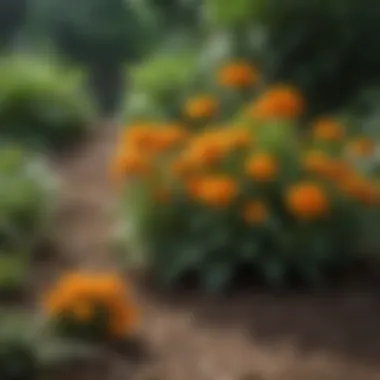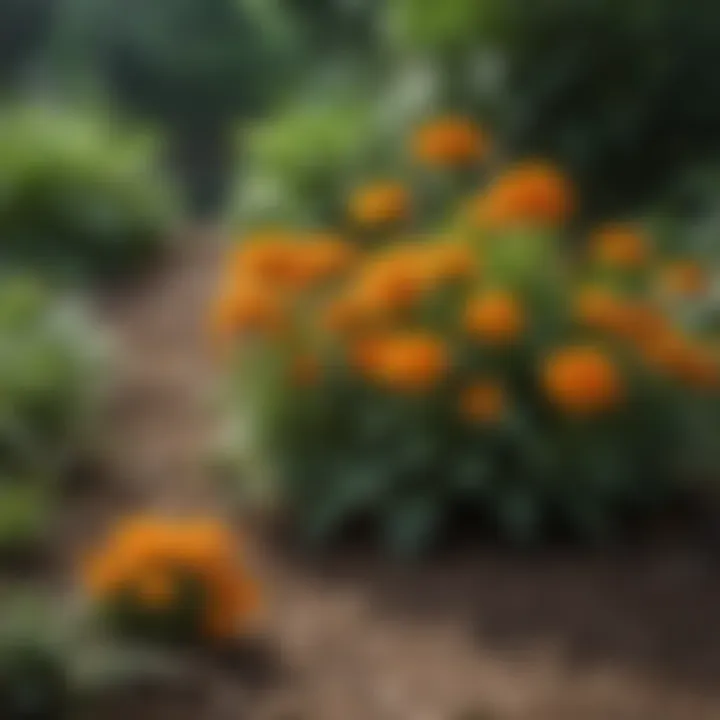Natural Defenses: Plants That Keep Mosquitoes Away


Intro
With the arrival of warm weather, many people look forward to spending time outdoors—except, of course, when mosquitoes show up uninvited. These pesky insects are more than just a nuisance; they can transmit diseases and spoil the peace of an otherwise enjoyable day. Fortunately, there’s a natural remedy growing right in your backyard or at your local garden center. Plants known for their mosquito-repelling properties are not only effective at keeping these annoyance at bay, but they also beautify your living spaces. This comprehensive guide will delve into how these plants function, which ones work best, and how you can integrate them elegantly into your gardens or homes.
By unlocking the secrets of nature’s defenses, you'll learn not only to repel mosquitoes but also to create a more harmonious outdoor environment.
Gardening Know-How
Plant Care Guides
Choosing the right plants to discourage mosquitoes is essential. Some of the most well-known are Citronella, Lavender, and Marigold. These species contain organic compounds that mosquitoes find unpleasant. Learning the proper care of these plants ensures they thrive:
- Citronella Grass: This tall, aromatic grass requires sunlight and well-drained soil. It needs watering during dry spells but avoid waterlogged conditions.
- Lavender: Not just fragrant, lavender thrives in dry, sunny spots. Prune it back after flowering to promote new growth.
- Marigolds: Tough little flowers that not only repulse mosquitoes but also attract beneficial insects. Marigolds prefer full sun and well-drained soil.
Seasonal Gardening Tips
Timing can be critical for establishing a mosquito-repelling garden. Here are some tips:
- Spring: Start your mosquito-deterring garden early in the spring. This is prime time for planting species like Lavender, which needs a good start.
- Summer: Maintain regular watering routines and deadhead flowers to promote growth throughout the summer months.
- Fall: As the weather cools, some plants may need re-potting for indoor storage. Consider placing pots of Citronella near doorways or windows to maintain effective deterrence during indoor gatherings.
DIY Garden Projects
Creating a bug-repelling sanctuary doesn’t have to be complicated. Here are a few ideas:
- Create a mosquito-repelling border: Plant Marigolds along pathways or borders, where people frequently walk. Their bright colors and strong scent will add a cheerful touch while keeping the bugs away.
- Container Gardens: For those with limited space, pots filled with Lavender or Citronella can thrive on patios, balconies, or window sills.
- Herbal Blends: Mixing basil and mint with your mosquito-repelling plants can enhance the efficacy, as the compounds in these herbs also deter pests, and they can be used fresh in cooking or tea.
"A well-placed plant can do wonders beyond décor; it can create comfort while fighting off nuisances!"
Outdoor Living Spaces
Creating Cozy Outdoor Retreats
Imagine a serene backyard, filled with the sweet smell of flowers and the soft rustle of plants. Integrating mosquito-repelling flora not only enhances aesthetics but creates a cozy, welcoming retreat for family and friends:
- Planters and Pots: Use decorative pots to hold your mosquito-repelling plants near seating areas to keep unwanted guests away.
- Trellises and Vertical Gardens: Grow climbing plants that repel mosquitoes up trellises against fences, combining practicality with a striking visual element.
- Natural Barriers: Arrange plants strategically to form a natural barrier around your outdoor spaces, promoting privacy while warding off mosquitoes effectively. Studies show that such arrangements can keep mosquitoes at bay without the need for chemical repellents.
Closure
Engaging with the natural world offers solutions that benefit not just individual comfort, but also environmental wellness. By embracing plants like Citronella and Lavender, you can enjoy your outdoor spaces while effortlessly keeping mosquitoes at a distance. This approach to pest control fits perfectly in a time when many homeowners are seeking greener alternatives to traditional methods. Plus, the inclusion of these species beautifies your surroundings and adds a level of charm that brings life to your gardens and patios.
Understanding Mosquito Attraction
Understanding what attracts mosquitoes is not just a matter of curiosity; it’s crucial for developing effective repelling strategies. This knowledge lays the groundwork for those who wish to embrace plants that deter these pests. By comprehending the allure of humans to mosquitoes, we can better utilize natural defenses in our gardens and homes, making our environments less inviting to these unwelcome guests.
The Biology of Mosquitoes
Mosquitoes belong to a diverse family of insects that thrive in various climates. Interestingly, there are over 3,500 species worldwide, but only a small fraction are known to bite humans. Their life cycle consists of four stages: egg, larva, pupa, and adult. Each stage is essential, yet it’s the adult mosquitoes we often contend with.
In the adult stage, females primarily seek out blood to provide essential nutrients for their eggs. This is where their biology gets fascinating. The females possess specialized mouthparts that enable them to extract blood from their hosts. Moreover, their sensory organs are finely tuned to environmental cues. They can detect carbon dioxide, heat, and certain body odors from a distance, which guide them toward potential hosts.
Understanding these biological processes is vital not only for scientists but also for homeowners and gardeners who wish to minimize mosquito populations in their areas.
What Draws Mosquitoes to Humans
A combination of factors draws mosquitoes to humans. While many people assume it’s merely the sweet scent of sweat or a tempting sweet fragrance, the reality is far more complex. Here are some key elements that make certain individuals more appealing:
- Carbon Dioxide: It’s no secret that as we breathe, we release carbon dioxide. Mosquitoes can sense this gas up to 100 feet away and are instinctively drawn toward it.
- Body Heat: Mosquitoes are also attracted to warmth. The body heat that we emit, particularly in areas with a higher concentration of blood vessels, signals a potential target.
- Skin Bacteria: What may surprise you is that the bacteria living on our skin can influence how attractive we are to mosquitoes. Different people have varying skin flora, and some bacterial compositions are more enticing to mosquitoes than others.
- Lactic Acid and Other Chemicals: After physical activity, lactic acid and other substances accumulate in our sweat, which can elevate our attractiveness to these pests. This might explain why athletes or those who engage in outdoor activities often find themselves swarmed by mosquitoes.
"Understanding what draws mosquitoes helps us not just in minimizing their presence, but in utilizing plants effectively to repel them."
All of these factors contribute to an intricate dance of attraction, making it essential for those wishing to keep mosquitoes at bay to take steps in mitigating these appealing factors. By doing so, celebrations in the open air can remain blissfully pest-free.
Why Use Plants for Mosquito Control
Mosquito control is more than just a seasonal must; it's an ongoing consideration for anyone looking to keep their outdoor spaces enjoyable. The role of plants in this arena is two-fold: they not only provide aesthetic beauty to your garden but also offer a practical solution to an age-old problem—mosquitoes. By using plants that naturally deter these pests, homeowners can create a refreshing environment that thrives without relying heavily on synthetic chemicals. This method caters not just to your garden’s charm but also to your family's health.
Environmental Benefits of Natural Repellents
Using plants as mosquito repellents comes with significant environmental benefits. When you opt for natural solutions, you inadvertently protect local ecosystems. Gardeners should be aware that synthetic chemicals often pose risks to beneficial insects, birds, and other wildlife. In contrast, cultivating mosquito-repelling plants helps to maintain biodiversity.
Here are some key points outlining these benefits:
- Ecosystem Friendly: Plants like Citronella and Lavender aid in keeping mosquito populations in check without the collateral damage that chemical sprays may inflict on beneficial insects.
- Reduced Chemical Load: By incorporating these plants into your environment, you lessen the need for harsh pesticides in your yard. Pesticides often wash away in rain, contaminating local water bodies and harming aquatic life.
- Sustainable Practices: Many of these plants are easy to grow and can regenerate year after year. This promotes a sustainable gardening approach where you rely more on nature to find balance.


As gardening enthusiasts tap into these natural defenses, they promote a healthier, more vibrant environment.
The Efficacy of Plant-Based Solutions vs. Chemical Products
When it comes to effective mosquito control strategies, the debate between plant-based solutions and chemical products often raises eyebrows. While it’s easy to reach for the latest aerosol spray to swiftly eliminate pests, the long-term effectiveness and safety of plant-based solutions usually win the day.
Research shows that many plants contain essential oils that not only repel mosquitoes but also hinder their ability to breed. For example, the oil extracted from Catnip is found to be ten times more effective than DEET, a common chemical insect repellent. A few points of consideration include:
- Natural Longevity: Unlike synthetic repellents that often require reapplication every few hours, natural options derived from plants can last for longer periods when strategically placed in your garden or home.
- Health Advantages: Using plants means fewer chemicals around your family, leading to a reduction in potential health risks associated with pesticide exposure. Children and pets, in particular, benefit from less chemical noise in their environment.
- Efficacy Rates: The potency of certain plant repellents can be astonishing. It’s not uncommon to find that simple herbs, when properly used, provide a barrier strong enough to deter mosquito presence significantly.
Key Plants That Repel Mosquitoes
In the ongoing battle against mosquitoes, many homeowners and gardening enthusiasts are turning their gaze toward natural solutions. Utilizing plants known for their mosquito-repelling abilities not only helps in creating a more pleasant living environment but also aligns with eco-friendly practices. Leveraging plants that drive away these pesky insects offers dual benefits: enhancing the aesthetic appeal of gardens and diminishing reliance on chemical pesticides.
The plants highlighted in this section all possess qualities that make them stand out as effective defenses against mosquitoes. Each one brings something unique to the table, catering to a variety of growing conditions and personal preferences.
Citronella Grass
Growing Conditions and Care
Citronella grass, well-known as a mosquito repellent, thrives in warm and sunny environments. It needs well-draining soil, as it doesn't enjoy being waterlogged. It's quite hardy, making it a popular choice for many gardeners. The grass can grow to about five to six feet tall, providing a lush green backdrop in adding a tropical feel to any garden.
One key feature of growing citronella grass is that it requires regular trimming to remain healthy; without this, it can become overgrown and less effective. Ideally, plant it in clusters where it can create a dense barrier. The advantage of cultivating this grass lies in its low-maintenance nature, though it may not fare well in colder regions.
How It Works as a Repellent
The effectiveness of citronella grass stems from the essential oils it contains, especially citronellal. This oil masks scents that attract mosquitoes, making it harder for them to find hosts. When citronella is rubbed on the skin or burned as a candle, it can help ward off mosquitoes, making it a practical choice for evening outdoor gatherings.
However, the downside is that its effects may diminish quickly, especially in windy conditions or when not freshly cut. To maximize the benefit, strategic placement near outdoor seating areas is recommended.
Lavender
Fragrance and Mosquito Deterrence
Lavender is often cherished for its delightful aroma, and it turns out mosquitoes share that fondness for other scents instead. The fragrance of lavender is known to be unpleasant for these insects, effectively keeping them at bay. The most common variety with repelling properties is Lavandula angustifolia.
Its striking purple flowers not only look great but also attract beneficial insects, which boosts overall garden health. Beyond aesthetics, lavender's essential oil can be used directly on the skin, offering a pleasant and natural way to deter mosquitoes. Though it's quite effective, the downside is that its scent might not last as long as one would wish in hotter climates.
Best Planting Techniques
When planting lavender, well-drained sandy or gravelly soil is ideal. It thrives in full sun and requires minimal watering once established. Plant it in clusters for an impressive display and optimal efficiency in warding off mosquitoes. Overwatering can lead to root rot, so one should tread lightly here. Lavender can be a bit particular about its surroundings, but the effort is worth it for its dual-purpose appeal.
Marigolds
Companion Planting Benefits
Marigolds go beyond just their bright and cheerful blooms. They are also highly valued in companion planting for their ability to repel mosquitoes. The flowers emit a scent that repels a variety of insects, including nematodes, therefore they could play a vital role in pest management when planted alongside vegetables and herbs.
One unique feature of marigolds is their adaptability; they thrive in a range of soils and conditions, making them a great addition to any garden. While the plus side is that they're relatively low-maintenance, there's just a slight risk of attracting other pests like aphids if not properly managed.
Varieties to Consider
When selecting marigolds, Tagetes patula (French marigold) and Tagetes erecta (African marigold) rank high on the list. They have the best repelling qualities with a bright yellow to orange hue that draws the eye. While marigolds are easy to grow, gardeners should still consider any specific sunlight and soil requirements to ensure optimal growth. They bloom continuously throughout the growing season, ensuring their presence at every outdoor gathering.
Basil
Culinary Use and Repellent Properties
Basil, a culinary staple in many kitchens, also offers potent mosquito-repelling capabilities. Known for its strong scent, it can act as a deterrent when planted outdoors or even potted indoors. Varieties like Italian sweet basil are particularly effective.
The unique aspect of basil's repellent properties lies in its essential oils, which mosquitoes find overwhelmingly pungent. This versatility makes basil a popular choice among those who appreciate its use both in cooking and in keeping pests at bay.
Cultivation Tips
Basil flourishes in warm, sunny spots with rich, well-drained soil. It thrives with regular watering but dislikes heavy moisture holding. The essential tip would be to pinch off the flowers to encourage bushier growth, easily providing both a deterrent and culinary herb. However, it's worth noting that basil can attract whiteflies, requiring monitoring, especially in indoor plants.
Catnip
Unique Chemical Compounds
Catnip, or Nepeta cataria, is both a blessing and a curiosity. While it is known to captivate cats, it also contains Nepetalactone, a compound that mosquitoes find unappealing. Intriguingly, while many will enjoy the plant's effect on felines, mosquitoes tend to shy away from areas where it's grown.
The specific advantage of catnip is that it’s a vigorous grower, making it an easy choice for those looking for quick results. However, its effective repellent properties may not be as extensively studied as other plants, leaving some room for further exploration.


Planting and Maintenance
Catnip loves full sun and will adapt to various soils, though well-draining ones provide the best results. With little required maintenance, it can spread rather quickly, so control measures may be needed. One tiny downside is that it can sometimes attract more bees due to its fragrant flower. Keep in mind that this is a boon for garden biodiversity.
Peppermint
How Peppermint Oil Affects Mosquito Behavior
Peppermint oil, extracted from Mentha piperita, has a strong odor that mosquitoes dislike. This plant contains significant amounts of menthol, which is why many commercial mosquito repellents feature peppermint oil. The unique feature of peppermint is its ability to work both as a repellent and a pleasant scent for humans, making it a great choice for outdoor lounges.
However, not all effects last for long. Frequent reapplication may be necessary, especially after heavy rain or prolonged exposure to sunlight.
Gardening Considerations
Peppermint enjoys slightly cooler temperatures and can spread aggressively. It’s advisable to plant it in pots or confined spaces where you want it to grow. Gardeners must keep it well-watered but ensure that water doesn't pool, as this may cause rot. While it's often overlooked, peppermint thrives alongside other herbs, amplifying garden appeal and effectiveness at pest control.
Creating a Mosquito-Repelling Garden
Creating a mosquito-repelling garden isn’t just an endeavor; it’s a smart strategy woven into the fabric of sustainable living. As more people seek to enjoy their outdoor spaces without the constant buzzing of mosquitoes, these gardens not only bring beauty but also serve a functional purpose. By selecting plants known for their repellent properties, homeowners can cultivate a tranquil environment that merges aesthetics with practicality.
This approach offers several benefits. Firstly, by decreasing the mosquito population around your home, you create a safer space for family gatherings or quiet evenings in the backyard. Secondly, such gardens can enhance biodiversity, inviting beneficial insects to thrive alongside the plants that deter pests. The use of natural repellents is an eco-friendly alternative to chemical sprays that can have harmful effects on the environment and human health. Engaging in the design and maintenance of these gardens fosters a deeper connection to nature, allowing homeowners to play an active role in pest management.
Designing Your Garden Layout
Strategic Plant Placement
Strategic plant placement is a cornerstone of designing an effective mosquito-repelling garden. This involves carefully selecting where to position your mosquito-repelling plants based on factors like sunlight exposure, airflow, and proximity to swiming pools or stagnant water—areas where mosquitoes often breed. By grouping plants that attract beneficial insects or repel mosquitoes, the efficacy of your garden can significantly increase.
One of the key characteristics of this technique is the idea of zoning. Placing your citronella grass away from areas with ready access to water can help mitigate mosquito presence. Out in the open, with proper airflow, these plants can release their natural oils efficiently. A unique feature of strategic plant placement is the concept of companion gardening, often used by seasoned gardeners. By pairing plants that support each other’s growth, you enhance not only their individual effectiveness in repelling pests but also establish a more cohesive gardening ecosystem.
Maximizing Efficacy
Maximizing efficacy involves ensuring that your garden design truly serves its purpose of repelling mosquitoes. This includes considering factors like plant size, leaf surface area, and the enigmatic world of plant interactions. For instance, larger plants may create shade that could harbor mosquitoes, generating a conflicting outcome. Thus, it’s essential to balance the garden's overall appearance while keeping this efficacy in mind.
The key characteristic here lies in optimizing each plant’s role. For example, clustering fragrant herbs like lavender and basil together can amplify their respective scents that deter mosquitoes when the wind carries this blend. A unique feature of this maximization strategy is the timing of plant growth; certain plants may be more effective during specific seasons. Evaluating each element can reveal both advantages and potential disadvantages, ensuring that your garden operates at peak performance throughout its lifespan.
Maintaining a Healthy Growth Environment
Watering and Soil Requirements
Watering and soil requirements are critical to the success of any garden, and they play an especially important role in a mosquito-repelling garden. Establishing the right soil conditions can help your plants flourish, allowing them to release the essential oils that deter pests effectively. Different plants may have varying needs; for instance, basil often thrives in well-draining, nutrient-rich soil, while marigolds may be more tolerant of poor soil conditions.
One beneficial aspect about configuring watering schedules based on your plant’s needs is that it prevents over-saturation, which could inadvertently create a breeding ground for mosquitoes. Additionally, maintaining consistent moisture levels can help healthy plants reach their full mosquito-repelling potential.
A unique feature to keep in mind is the idea of moisture retention through mulch. This can not only support healthy growth but can also diminish surface water that mosquitoes need for breeding, giving your garden an extra layer of defense against these pests.
Common Pests and Diseases
In any gardening efforts, common pests and diseases can emerge, creating challenges to achieve the desired aesthetically pleasing and functional environment. Monitoring for any signs of trouble assists in the early detection of threats like aphids or fungal diseases that can affect healthy plants. This aspect of maintaining a healthy garden goes hand-in-hand with the overarching goal of repelling mosquitoes.
The key characteristic here involves vigilance—inspect your plants regularly and act swiftly at the first sign of trouble. Early intervention can make a world of difference.
One unique feature of understanding these common pests is the concept of creating barriers using other plants; some species can act as natural deterrents not just to mosquitoes but to other garden pests as well. This easy DIY approach enhances your garden's health while simultaneously combating various issues that could derail your mosquito-repelling efforts.
Integrating Mosquito-Repelling Plants Indoors
Integrating mosquito-repelling plants indoors offers a practical approach to creating a more comfortable living environment. Beyond aesthetics, these plants can serve a dual purpose by enhancing air quality while simultaneously working to deter those pesky mosquitoes. This section not only highlights specific plants that thrive indoors but also delves into care guidelines and spatial considerations crucial for effective pest control.
Choosing the Right Indoor Plants
Selecting the right plants is foundational when it comes to effectively integrating mosquito-repelling species indoors. Some plants possess scents or oils that are naturally unappealing to mosquitoes. For instance, citronella and lavender rank high on the list due to their potent aromas. Peppermint also stands out; its fragrance can act as a powerful deterrent. Other options include basil and catnip, both not only useful for their culinary value but also beneficial in keeping those unwelcome insects at bay.
For those less familiar with plant care, it's often wise to opt for sturdy species known for thriving in less-than-ideal conditions. The hardiness of these varieties ensures that they can adapt to a range of indoor environments, making them perfect for anyone, from planning novices to gardening enthusiasts.
Care Guidelines for Indoor Cultivation
Light and Temperature Considerations
When considering light and temperature for indoor plants, one must pay close attention to how these factors influence overall growth. Most mosquito-repelling plants thrive in bright, indirect light. This characteristic is particularly valuable because it often aligns well with typical indoor lighting conditions. A common mistake is placing these plants in direct sunlight, which can scorch their leaves.
The ideal temperature for many of these plants falls between 65°F and 75°F. Maintaining a consistent temperature in this range can prevent stress on the plants, leading to healthier growth and more effective pest-repelling properties. Additionally, this optimal temperature can create a comfortable atmosphere for both plants and inhabitants alike.
Exploring Scientific Studies on Plant Efficacy


Understanding how certain plants can ward off pesky mosquitoes is more than just a backyard curiosity. Scientific research into plant efficacy reveals the underlying mechanisms behind their repellent properties and informs us about their practical applications. This topic sheds light on the promises and limitations of using plants for pest control, providing homeowners and gardening enthusiasts with valuable insights into eco-friendly solutions.
Research validates the notion that plants can indeed offer protection against mosquitoes, but it also uncovers the complex nature of these interactions. For instance, not all plants repel mosquitoes equally, and some might work better under specific conditions. Therefore, familiarity with the science behind these natural repellents helps in optimizing their use, ensuring that a garden doesn’t just look nice but serves a functional purpose as well.
Research on Plant Oils and Their Effects
Various studies have examined the effectiveness of essential oils derived from specific plants, each showing varying degrees of success in repelling mosquitoes. For example, research conducted on citronella oil shows that it can provide considerable protection when applied in concentrated forms.
- Key findings include:
- Duration of Effectiveness: Studies indicate that while citronella oil may repel mosquitoes for about 30 minutes to an hour, reapplication is often required for continued protection.
- Concentration Levels: Recommended concentrations of oil also play a crucial role; higher concentrations can enhance efficacy.
Essential oils from plants like eucalyptus and lavender have also demonstrated efficacy. Eucalyptus oil has shown the ability to deter mosquitoes due to its active compound, 1,8-cineole. This chemical interferes with the mosquitoes' olfactory senses, making it harder for them to locate their prey.
"Alternative natural repellents are gaining attention for their potential in integrated pest management."
It's worth noting that vital components in these oils can also trigger allergic reactions in some individuals, making it essential to conduct skin tests if using them directly. Furthermore, the overall effectiveness might be influenced by environmental factors, such as temperature and humidity, further complicating their reliable use.
Historical Use of Plants in Pest Control
Humans have utilized plants for pest control for centuries, a practice often seen in indigenous and traditional agricultural systems. Historical records reveal that various cultures relied on plants for their repellent properties long before the advent of synthetic chemicals. For instance, the use of neem leaves in India and garlic in several nations demonstrates this age-old wisdom passed through generations.
- Some notable examples of historical uses include:
- Neem: Used in ancient Ayurvedic texts, neem leaves were revered for their insect-repelling qualities. They contain compounds that exhibit both insecticidal and repellent properties.
- Garlic: Its pungent smell has been known to keep mosquitoes at bay, and studies confirm that certain compounds found in garlic can interfere with the pests' ability to locate hosts.
Research into these historical practices not only echoes the efficacy of naturally derived solutions but also encourages a return to time-tested methods that can complement modern pest control strategies.
Through such scholarly exploration, both the historical context and modern implications guide us in creating a more harmonious coexistence with nature—blending the knowledge of the past with the insights of the present.
DIY Recipes Using Mosquito-Repelling Plants
When it comes to the age-old battle against mosquitoes, turning to our green friends can be quite fruitful. Not only are these natural defenses effective, but they can also be fun to craft. DIY recipes using mosquito-repelling plants empower homeowners, gardeners, and even party hosts to take control of their space without resorting to harsh chemicals. By making your own repellent products using essential oils and plants identified for their mosquito-dissuading properties, you not only foster a personal connection with your environment but also promote a healthier ecosystem.
The beauty of creating your own mosquito deterrents lies in the flexibility and customization they offer. You can fine-tune your blends to your specific preferences, all while ensuring that hazardous substances are kept at bay. Moreover, these natural solutions often come at a fraction of the cost of commercial products, making them both economical and effective.
In this section, we’ll explore two primary avenues for crafting mosquito repellents: essential oil blends that harness the power of plants, and homemade mosquito sprays that combine various ingredients for maximum efficacy.
Essential Oil Blends for Mosquito Deterrence
Essential oils serve as the cornerstone for many natural repellents because of their concentrated potency. The process of creating an oil blend can be as simple or elaborate as you want.
Ingredients:
- Citronella oil: Known for its strong scent that interferes with mosquito attraction
- Lavender oil: A calming fragrance that also keeps these pests at bay
- Peppermint oil: Provides a refreshing aroma while deterring mosquitoes
- A carrier oil, like jojoba or coconut oil, to dilute the essential oils
Instructions:
- In a small glass bottle, mix together 10 drops of citronella oil, 8 drops of lavender oil, and 5 drops of peppermint oil.
- Add roughly 2 tablespoons of your carrier oil to the blend.
- Shake well before each use.
- Apply sparingly on exposed skin or in areas where mosquitoes tend to congregate.
Homemade Mosquito Sprays
Creating a spray allows for a different flexibility. You can concoct bigger batches to cover larger areas, like gardens or patios. Here’s a straightforward recipe that combines several mosquito-repelling plants into a single powerful spray.
Ingredients:
- Water: 1 cup
- Witch hazel or vodka: 1/4 cup, acts as a preservative
- Crushed leaves from basil and catnip: about 1/4 cup each, potent mosquito repellents
- Optional: a few drops of essential oils like eucalyptus or tea tree for enhanced protection.
Instructions:
- Boil the water and pour over the crushed basil and catnip in a glass jar. Allow it to steep for about 30 minutes.
- Strain the liquid to remove solids.
- Mix the infused water with the witch hazel (or vodka) in a spray bottle.
- Add essential oils if you’re using them, then shake well.
- Spray around your living area or directly onto skin as desired.
In summary, DIY recipes for mosquito-repelling plants yield practical and creative results. By utilizing the power of essential oils and crafting homemade sprays, individuals can develop eco-friendly solutions that resonate well beyond mere functionality. No one wants to be eaten alive by those pesky pests, so the next time you find a horde of mosquitoes vying for your attention, consider these natural alternatives before reaching for a can of chemicals.
Culmination: Embracing Natural Solutions
In concluding our exploration into the natural defenses against mosquitoes, we see that the use of plants to repel these pesky invaders is not only a practical choice but also an eco-friendly one. Homeowners and gardening enthusiasts alike are increasingly recognizing the importance of integrating such natural solutions into their pest control measures. Beyond just offering an alternative to chemical repellents, these plants serve as reminders of the biodiversity that surrounds us and the role it plays in pest management.
By embracing plant-based repellents, individuals can minimize their environmental impact while enhancing the aesthetic appeal of their living spaces. Plants like citronella grass and lavender not only make gardens vibrant but also contribute to a healthier ecosystem. The natural mechanisms these plants employ—such as emitting oils that mosquitoes find unappealing—highlight nature's ability to fend off unwanted pests effectively without harmful side effects.
Summary of Key Takeaways
- Natural Repellents Deter Mosquitoes: Implementing plants known for their mosquito-repelling properties can significantly reduce unwanted insect presence.
- Environmental Considerations: Utilizing natural solutions leads to lower chemical usage, promoting sustainable gardening practices.
- Variety of Options: A plethora of effective plant choices exists, from common herbs like basil to aromatic flowers like marigolds.
- Long-Term Benefits: Creating a garden designed to repel mosquitoes not only brings immediate relief but nurtures the environment over time.
The Future of Natural Pest Control
The horizon of natural pest control appears promising. As awareness grows around the adverse effects of synthetic pesticides, the shift toward natural solutions could gain momentum. Scientific research continues to unveil new insights into the efficacy of various plants, opening doors for innovative combinations and techniques in gardening. Furthermore, the collective effort by communities to adopt these practices could reshape local ecosystems in ways that benefit human inhabitants and wildlife alike.
As we look ahead, educational initiatives that emphasize the benefits of plant-based repellents can assist in fostering a culture of sustainable gardening. Such proactive measures might influence policy changes, promoting regulations that favor natural pest control methods over conventional chemicals. In sum, embracing these natural solutions not only enhances personal spaces but also aligns with the broader goals of environmental stewardship.







